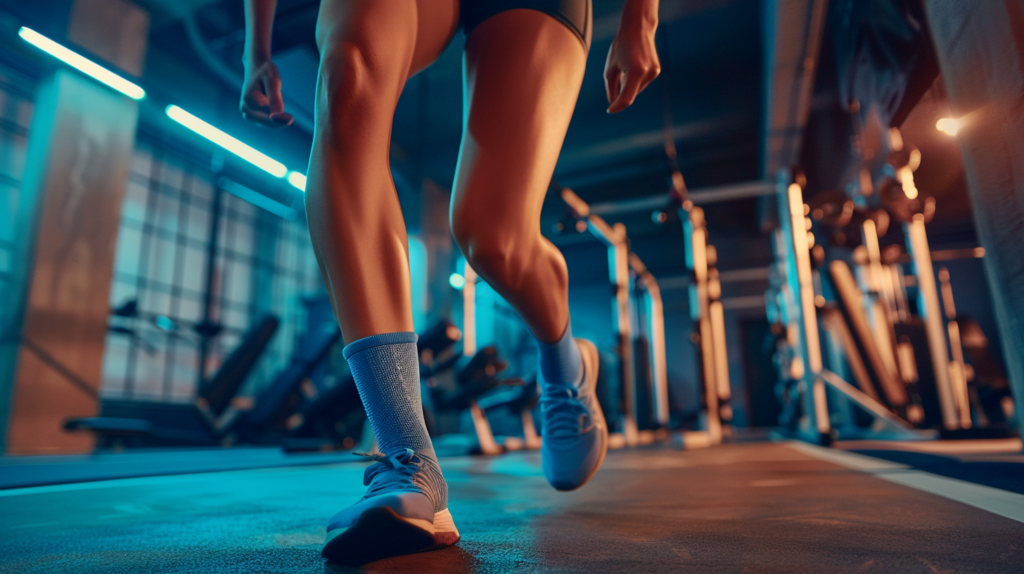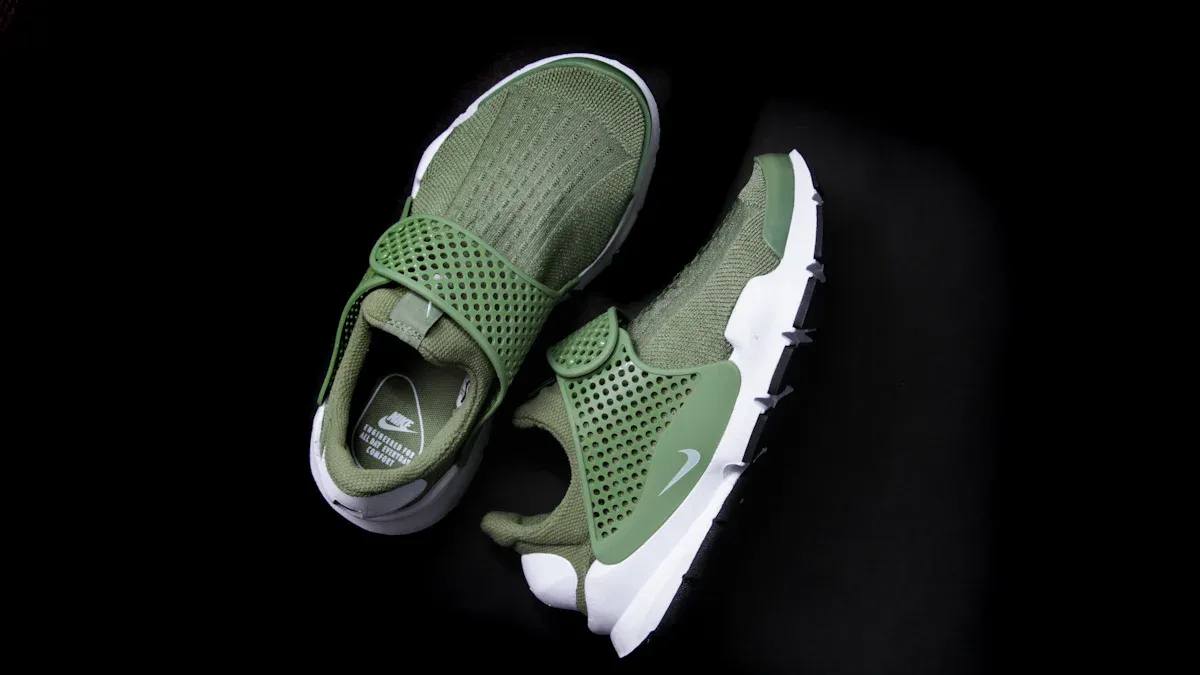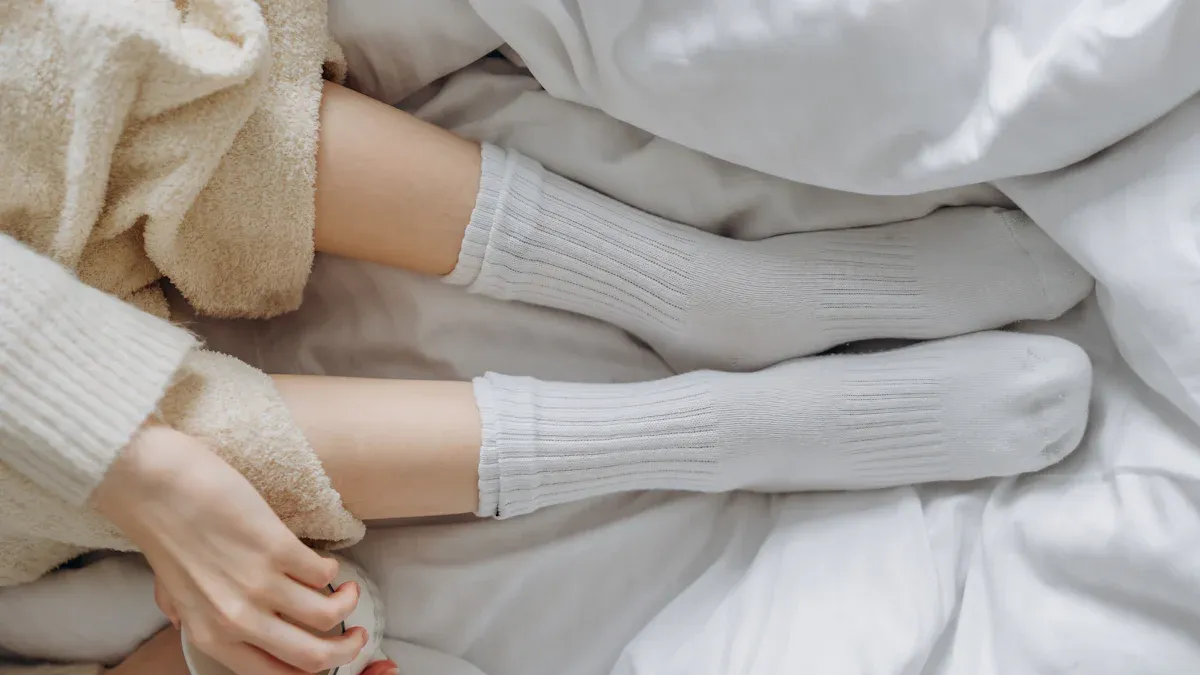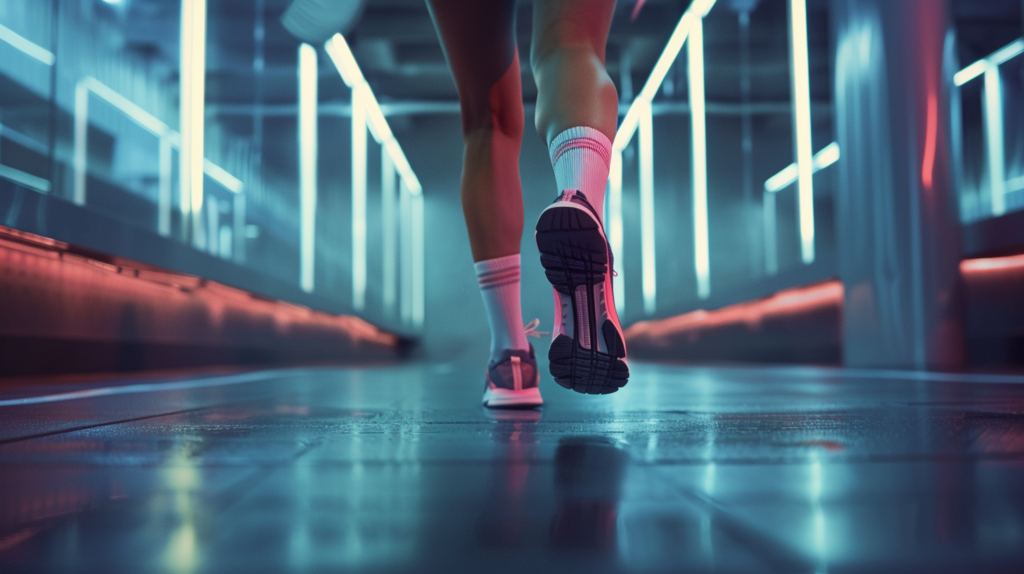
You can reduce your risk of foot fungus by choosing breathable socks.
These socks keep your feet dry by allowing air to circulate, which prevents moisture buildup. Fungi thrive in damp, warm environments, so reducing moisture makes it harder for them to grow. Research shows that footwear designed for airflow helps people, especially those with sweaty feet, avoid fungal infections.
Adding breathable socks to your daily routine creates a healthier environment for your feet and supports long-term foot health.
Key Takeaways
- Breathable socks help keep feet dry by letting air flow.
- Use socks made of materials like merino wool or bamboo.
- Pick socks with mesh panels for better airflow and cooling.
- Change your socks often, especially after sweating, to stay healthy.
- Don’t walk barefoot in shared spaces to avoid germs and fungi.
How Breathable Socks Help Prevent Foot Fungus?
Moisture-wicking properties
Breathable socks excel at keeping your feet dry by using moisture-wicking materials. These materials pull sweat away from your skin and allow it to evaporate quickly. By reducing moisture, you create an environment where fungi struggle to grow. This feature not only helps prevent foot fungus but also keeps your feet comfortable throughout the day.
Some socks go a step further by incorporating advanced treatments like silver ions. These treatments prevent bacteria from growing, which helps control odor. Additionally, many breathable socks include mesh panels or special knit patterns. These designs improve airflow, ensuring your feet stay dry even during intense physical activities.
Tip: Look for socks labeled as "moisture-wicking" or "odor-resistant" to maximize these benefits.
Enhanced airflow and ventilation
The design of breathable socks prioritizes airflow, which plays a key role in keeping your feet healthy. Socks with better ventilation allow air to circulate freely, reducing heat and moisture buildup. This improved airflow helps maintain a cooler and drier environment for your feet, making it harder for fungi to thrive.
Different sock types offer varying levels of air permeability. For example, single-yarn socks provide higher air permeability and thermal conductivity, making them ideal for breathability. On the other hand, socks made with thicker materials or higher cotton content tend to trap more heat and moisture. Interestingly, washing cotton socks can enhance their air permeability, further improving ventilation.
| Sock Type | Air Permeability | Thermal Conductivity | Thermal Resistance |
|---|---|---|---|
| Single Yarn Socks | Higher | Higher | Lower |
| Plated Socks (Polyester) | Lower | Lower | Higher |
| Plated Socks (Lycra) | Lowest | Lowest | Highest |
Note: Choose socks with lightweight fabrics and mesh designs for the best ventilation.
Antimicrobial features for added protection
Many breathable socks include antimicrobial properties to provide extra protection against foot fungus. These socks use special treatments to inhibit the growth of fungi and bacteria. By doing so, they reduce the risk of infections and keep your feet healthier. Antimicrobial socks also work hand-in-hand with moisture-wicking technology. Together, they ensure your feet stay dry and free from harmful microbes.
Breathable materials further enhance this protection by allowing air to circulate. This prevents moisture from accumulating, which is a key factor in fungal growth. When you combine these features, you get socks that not only prevent foot fungus but also promote overall foot health.
Tip: Look for socks with antimicrobial labels or those made with natural materials like bamboo, which naturally resist bacteria and fungi.

What is the Key Features of Breathable Socks?
Best materials for moisture control
Choosing the right material is essential for keeping your feet dry and comfortable. Some of the best materials for moisture control include merino wool, bamboo, and synthetic blends. Each of these materials offers unique benefits that make them ideal for breathable socks.
Merino wool is a popular choice for its ability to wick moisture away from your skin. It also regulates temperature, keeping your feet warm in cold weather and cool in warmer conditions. Bamboo fiber, on the other hand, is lightweight and naturally antibacterial. This makes it a great option for everyday wear, especially if you want to reduce odor and prevent fungal growth. Synthetic blends, such as polyester or nylon, are also effective. They dry quickly and often include additional features like mesh panels for enhanced airflow.
Merino wool is known for its fine fibers that provide softness, temperature regulation, and excellent moisture-wicking capabilities. Bamboo fiber is lightweight, breathable, and naturally antibacterial, making it ideal for everyday wear.
| Material | Feature | Benefit |
|---|---|---|
| Merino Wool | Moisture-wicking | Pulls sweat away, keeping feet dry and odor-free. |
| Breathability | Allows air flow, keeping feet cool. | |
| Temperature regulation | Provides warmth without heaviness. | |
| Bamboo Fiber | Moisture-wicking | Keeps feet dry, reducing blisters. |
| Breathability | Mesh areas enhance airflow. | |
| Comfort | Flat designs minimize rubbing on the skin. |
When selecting breathable socks, look for labels that highlight these materials. This ensures you get the best combination of moisture control and comfort.
Proper fit for comfort and effectiveness
The fit of your socks plays a crucial role in their effectiveness. Socks that are too tight can restrict airflow, while loose socks may bunch up and cause discomfort. A proper fit ensures that your socks stay in place and provide consistent breathability throughout the day.
To find the right fit, consider socks with elastic bands or arch support. These features help the socks conform to your foot shape without feeling restrictive. Additionally, check the size chart provided by the manufacturer. Wearing socks that match your shoe size prevents issues like slipping or pinching.
Tip: Always try on socks before purchasing to ensure they fit snugly but comfortably.
Properly fitting socks not only enhance comfort but also improve their ability to wick moisture and promote airflow. This makes them a key component of your foot care routine.
Thickness and design considerations for breathability
The thickness and design of your socks significantly impact their breathability. Thicker socks may provide extra cushioning, but they often trap heat and moisture. For better airflow, opt for thinner socks made with lightweight fabrics. These materials allow air to circulate freely, keeping your feet cool and dry.
Socks with mesh panels or ventilation zones are particularly effective. These features enhance airflow by allowing moisture to escape, which prevents issues like "swamp foot." Breathable designs also improve comfort during intense activities, such as running or hiking.
- Socks with mesh panels increase airflow and reduce sweat buildup.
- Lightweight fabrics prevent overheating and promote moisture evaporation.
- Proper breathability extends the lifespan of socks by reducing wear caused by trapped moisture.
Comfort is another important factor to consider. Socks designed for breathability often include flat seams or reinforced heels to prevent irritation. These small details make a big difference in how your socks feel during daily wear.
Breathability prevents issues like 'swamp foot,' which can lead to discomfort and health problems.
By choosing socks with the right thickness and design, you can enjoy both comfort and protection against foot fungus.

What is the Additional Tips for Preventing Foot Fungus?
Maintain proper foot hygiene
Keeping your feet clean is one of the most effective ways to prevent foot fungus. Wash your feet daily with soap and water, paying special attention to the areas between your toes. After washing, dry your feet thoroughly, as moisture left behind can encourage fungal growth. Moisturizing your feet can also help prevent cracks in the skin, which are entry points for pathogens.
Regularly inspect your feet and toenails for any changes in color, texture, or appearance. Early detection of fungal infections allows for quicker treatment. Additionally, sanitize nail clippers and pedicure tools after each use to avoid spreading fungi. If you visit a salon, ensure the pedicurist follows proper hygiene standards.
Note: Fungal infections can spread through contaminated surfaces. Always wash your hands after touching your feet or shared surfaces to reduce the risk of transmission.
Change socks regularly, especially after sweating
Sweaty socks create the perfect environment for fungi to thrive. Changing your socks frequently, especially after exercise or on hot days, helps keep your feet dry and healthy. Opt for breathable socks made from moisture-wicking materials like merino wool or bamboo. These materials pull sweat away from your skin, reducing the risk of fungal growth.
If you’re prone to excessive sweating, consider carrying an extra pair of socks to change into during the day. This simple habit can make a big difference in maintaining foot hygiene and preventing infections. Also, sprinkle an antifungal powder inside your shoes to keep them fresh and free of harmful microbes.
Tip: Alternate your shoes daily to allow them to dry out completely before wearing them again.
Pair breathable socks with breathable shoes
Wearing breathable socks alone isn’t enough if your shoes trap heat and moisture. Pair your socks with breathable shoes made from materials like mesh or leather. These shoes allow air to circulate, keeping your feet cool and dry. Studies show that combining breathable socks with footwear designed for moisture management significantly reduces moisture retention.
Avoid wearing the same pair of shoes every day. Alternating your footwear gives each pair time to dry out, preventing the buildup of moisture and odor. If you’ve recently treated a fungal infection, consider discarding old shoes to avoid re-infection.
Reminder: Trim your toenails straight across and avoid nail polish or artificial nails. These practices reduce moisture retention and lower the risk of fungal infections.
Avoid walking barefoot in communal spaces
Walking barefoot in communal spaces like locker rooms, public showers, and swimming pool areas exposes your feet to harmful microorganisms. These areas are often breeding grounds for fungi, bacteria, and viruses. Many people walk on these surfaces daily, leaving behind sweat, skin cells, and other contaminants. When you walk barefoot, your skin comes into direct contact with these pathogens, increasing the risk of infections like athlete's foot.
Even small breaks in the skin, such as tiny cuts or cracks, can serve as entry points for fungi. This makes it easier for infections to develop. To protect your feet, always wear footwear in communal spaces. Flip-flops or water shoes act as a barrier, preventing direct contact with contaminated surfaces. They also help keep your feet dry by reducing exposure to damp floors, which are ideal environments for fungal growth.
Tip: Keep a pair of flip-flops in your gym bag or by your shower to ensure you always have them when needed.
Maintaining clean and dry feet is another essential step. After using communal spaces, wash your feet thoroughly with soap and water. Pay attention to the areas between your toes, as they are prone to moisture buildup. Dry your feet completely before putting on socks or shoes. This simple habit reduces the chances of fungal infections.
- Why avoid walking barefoot in communal spaces?
- Fungi, bacteria, and viruses thrive in public showers and locker rooms.
- Bare feet increase exposure to harmful microorganisms.
- Small skin breaks make it easier for infections to occur.
By taking these precautions, you can significantly lower your risk of foot fungus. Wearing breathable footwear and practicing good hygiene ensures your feet stay healthy, even in shared environments.

Conclusion
Breathable socks offer a simple yet effective way to protect your feet from fungal infections. They keep your feet dry and ventilated, creating an environment where fungi cannot thrive. Pairing these socks with proper hygiene and breathable footwear enhances their benefits. Wash your feet daily, change socks regularly, and avoid walking barefoot in shared spaces. These habits, combined with high-quality breathable socks, ensure long-term foot health. Investing in the right socks and adopting these practices helps you maintain clean, healthy feet.
FAQ
What are breathable socks made of?
Breathable socks often use materials like merino wool, bamboo, or synthetic blends. These fabrics wick moisture away from your skin and allow air to circulate. This keeps your feet dry and cool, reducing the risk of fungal infections.
Tip: Check the label for moisture-wicking or breathable materials when shopping for socks.
How often should you change your socks to prevent foot fungus?
You should change your socks daily or more often if your feet sweat a lot. Fresh socks help keep your feet dry and prevent moisture buildup, which fungi need to grow.
Reminder: Always carry an extra pair of socks if you expect to sweat during the day.
Can breathable socks completely prevent foot fungus?
Breathable socks reduce the risk of foot fungus but don’t guarantee complete prevention. Combining them with good hygiene, breathable shoes, and regular sock changes offers the best protection.
Note: Avoid walking barefoot in communal spaces to further lower your risk.
Are cotton socks a good choice for preventing foot fungus?
Cotton socks are not ideal because they absorb moisture and dry slowly. This creates a damp environment where fungi thrive. Instead, choose socks made from moisture-wicking materials like bamboo or merino wool.
Fact: Cotton socks may feel soft but trap sweat, increasing the risk of fungal growth.
Do breathable socks help with odor control?
Yes, many breathable socks include antimicrobial treatments or natural materials like bamboo that resist bacteria and fungi. This helps control odor while keeping your feet healthy.
Emoji Tip: 🧦 Look for socks labeled "odor-resistant" for added freshness.
Related:
1.Bamboo vs Merino Wool: Which is Best? →
2.Finally, The Best Socks for Nail Fungus That Deliver Results →
3.Functional Properties Improvement of Socks Items Using Different Types of Yarn →
4.Beyond the Design: How Odor Control Sets Your Custom Socks Apart →
5.Foot Fungus: Best Treatments & Shoe Features For Condition →
